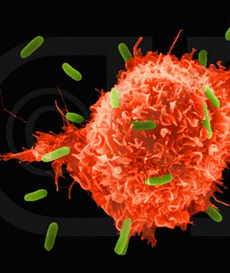fitness news
![]() ,
,![]()
Font size Cancer
Molecular Grenade Kills Tumor Cells in Mice
– Reported, July 10, 2012
 (Ivanhoe Newswire) Can a drug made from a weed cure cancer? Researchers and scientists are currently searching for an answer to that question, and they are one step closer after a new study showed that it destroyed tumor cells in mice.
(Ivanhoe Newswire) Can a drug made from a weed cure cancer? Researchers and scientists are currently searching for an answer to that question, and they are one step closer after a new study showed that it destroyed tumor cells in mice.
Scientists at the Johns Hopkins Kimmel Cancer Center and Danish researchers designed this novel anticancer drug to travel undetected through the bloodstream until activated by specific cancer proteins. The drug, derived from the weed from a weed called Thapsia garganica, has been shown to destroy cancers and their direct blood supplies while sparing healthy blood vessels and tissues.
A three-day course of the drug, called G202, was found to reduce the size of human prostate tumors grown in mice by an average of 50 percent within 30 days. G202 beat the chemotherapy drug Docetaxel, reducing seven of nine human prostate tumors in mice by more than 50 percent in 21 days.
Docetaxel reduced one of eight human prostate tumors in mice by more than 50 percent in the same time period. The researchers also reported that G202 produced at least 50 percent regression in models of human breast cancer, kidney cancer and bladder cancer.
Due to these positive results, Johns Hopkins physicians have performed a phase I clinical trial to assess safety of the drug and have so far treated 29 patients with advanced cancer. The University of Wisconsin and the University of Texas-San Antonio are also participating in the trial. A phase II trial to test the drug in patients with prostate cancer and liver cancer is in the works.
G202 is chemically derived from the Thapsia garganica weed which naturally grows in the Mediterranean region. The plant makes thapsigargin, which has been known to be toxic to animals since ancient Greece. In Arab caravans, it was known as the “death carrot” because it would kill camels if they ate it.
“Our goal was to try to re-engineer this very toxic natural plant product into a drug we might use to treat human cancer,” lead study author Samuel Denmeade, M.D., professor of oncology, urology, pharmacology and molecular sciences, was quoted as saying. “We achieved this by creating a format that requires modification by cells to release the active drug.”
Researchers disassembled thapsigargin and chemically modified it, creating a form likened to a hand grenade with an intact pin. The drug can be injected and travel through the bloodstream until it finds cancer cells and hits a protein called prostate-specific membrane antigen (PSMA). PSMA is released by cells that line tumors of the prostate and other areas, and in effect “pulls the pin” on G202, releasing cell-killing agents into the tumor and the blood vessels that feed it, as well as to other cells in the area.
G202 blocks the function of the SERCA pump protein, a housekeeping protein that is necessary for cell survival by keeping calcium level in cells at the correct level. The drug is targeted to the SERCA pump which all cells need to stay alive, thus making it harder for tumor cells to become resistant to the drug because they cannot stop making the protein.
“The exciting thing is that the cancer itself is activating its own demise,” senior study author John Isaacs, Ph.D., professor of oncology, urology, chemical and biomedical engineering at Johns Hopkins, was quoted as saying.
SOURCE: Science Translational Medicine, June 2012